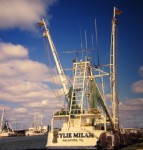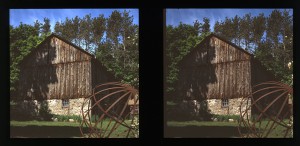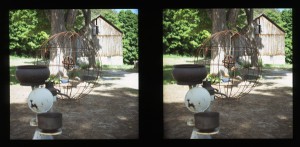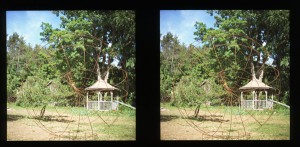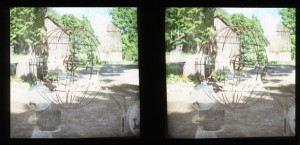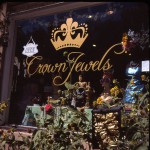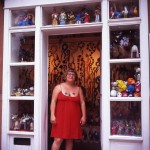 Taken at Rocky Mountain National Park in September 2011. Male elk taking it easy. Shot with the spud, handheld with available light.
Taken at Rocky Mountain National Park in September 2011. Male elk taking it easy. Shot with the spud, handheld with available light.
Do Not Talk To Prisoners Through Bars!
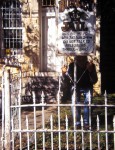 Taken in Burnet, Texas in 2014. This historic jail was built in 1884 of hand-hewn rock. It has an apartment for the sheriff who is also the jailer. On the second floor the county library was founded. The former jail is still being used by one of the county departments. The city of Burnet is nestled in the heart of the Texas Hill Country surrounded by rolling hills, lakes, beautiful geologic formations and historical sites. The historic square features buildings from as early as the 1880’s and offers a variety of unique shops and eateries. Drive in or take the Hill Country Flyer Historic Train (which is what we did) from Cedar Park, located on the edge of Austin. Watch the Burnet Gunfighter’s fight it out at the Old West Town on Saturday and Sunday. Taken with the TL120, available light handheld.
Taken in Burnet, Texas in 2014. This historic jail was built in 1884 of hand-hewn rock. It has an apartment for the sheriff who is also the jailer. On the second floor the county library was founded. The former jail is still being used by one of the county departments. The city of Burnet is nestled in the heart of the Texas Hill Country surrounded by rolling hills, lakes, beautiful geologic formations and historical sites. The historic square features buildings from as early as the 1880’s and offers a variety of unique shops and eateries. Drive in or take the Hill Country Flyer Historic Train (which is what we did) from Cedar Park, located on the edge of Austin. Watch the Burnet Gunfighter’s fight it out at the Old West Town on Saturday and Sunday. Taken with the TL120, available light handheld.
Goliad Market Days, Texas
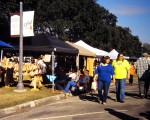 Goliad Market Days is an open air market which combines an arts and crafts fair, farmers market and community festival. Market Days are held to relive Goliad’s traditional role as a crossroads for commerce, beginning with the 1700s’ Spanish-colonial trade from Mexico to Nacogdoches. The tradition continued throughout the 19th century, as Goliad was included on the routes for oxcarts, freight wagons, and stagecoaches. Today, Goliad Market Days is one of the largest and most popular street markets in South Texas. Goliad is the third oldest municipality and is rich in Texas history. It is the County Seat of Goliad County, one of the oldest counties of Texas. First named Santa Dorotea by the Spaniards in the 16th century, its name was changed February 4, 1829 to Goliad. The name is an anagram derived from the last name of a Spanish missionary priest, Father Hidalgo.
Goliad Market Days is an open air market which combines an arts and crafts fair, farmers market and community festival. Market Days are held to relive Goliad’s traditional role as a crossroads for commerce, beginning with the 1700s’ Spanish-colonial trade from Mexico to Nacogdoches. The tradition continued throughout the 19th century, as Goliad was included on the routes for oxcarts, freight wagons, and stagecoaches. Today, Goliad Market Days is one of the largest and most popular street markets in South Texas. Goliad is the third oldest municipality and is rich in Texas history. It is the County Seat of Goliad County, one of the oldest counties of Texas. First named Santa Dorotea by the Spaniards in the 16th century, its name was changed February 4, 1829 to Goliad. The name is an anagram derived from the last name of a Spanish missionary priest, Father Hidalgo.
Palacios, Texas
Reflections on Lake Chapala, Mexico
 Lake Chapala is Mexico’s largest fresh water lake. It is located 45 km southeast of Guadalajara, Jalisco, and is situated on the border between the states of Jalisco and Michoacán, at 1,524 metres (5000 feet) above sea level. It is a shallow lake, with a mean depth of 4.5 metres (14.9 feet) and a maximum of 10.5 (34 feet). The lake is also a critical habitat for several species of migratory birds, such as the American white pelican, and home to thousands of indigenous plants and animals. It is also home to a large contingent of expats from Canada and the United States. It is a gorgeous place and I can see why people retire here.
Lake Chapala is Mexico’s largest fresh water lake. It is located 45 km southeast of Guadalajara, Jalisco, and is situated on the border between the states of Jalisco and Michoacán, at 1,524 metres (5000 feet) above sea level. It is a shallow lake, with a mean depth of 4.5 metres (14.9 feet) and a maximum of 10.5 (34 feet). The lake is also a critical habitat for several species of migratory birds, such as the American white pelican, and home to thousands of indigenous plants and animals. It is also home to a large contingent of expats from Canada and the United States. It is a gorgeous place and I can see why people retire here.
Wylie Milam
On Spaulding Meadow
The Spaulding Meadows are popular all year round. These are not meadows with cultivated hay fields. These are meadows in the second sense of the word, being areas of grass and flowers near the treeline. In the winter, they are very popular ski destinations, but the snowfall was so scant this year that there was virtually no skiing at all. They will often have snow in them until May, but by February 2015, the snow was gone. The images in this set are from a pair of trips I made to try to capture the combination of snow-free meadows and low-angle light.
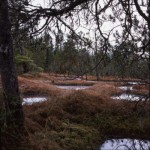 Spaulding Ponds
Spaulding Ponds
The ponds and pools in the meadows were still solid enough to walk across, so it made for very easy access to all corners of this space. I nestled in under a couple of trees to try to capture the frosty glint on the branch tips. I provided a little bit of fill-flash in an attempt to brighten the gloom under the trees.
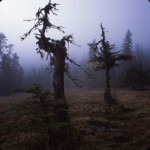 Two Towers
Two Towers
Despite the level of the clouds, I think you can gauge the height of the sun. This was about noon, so you can see that the sun doesn’t get very high in Juneau in the winter. I think this image effectively contains infinity without containing a horizon. This is a very common condition in Southeast Alaska. The weather is very close and we are often hiking in the clouds at less than 1,000 of elevation. This image was made at about 800‘ with my TL120-55.
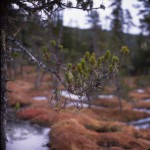 Spaulding Close Up
Spaulding Close Up
While enjoying a cup of tea and taking in my surroundings, I found myself staring at a tree. My attention was drawn to a low-lone branch. And further drawn to the tufts of needles on a twig on that branch. And here it is. I would have liked to close in on a single tuft, but the TL120-1 can’t focus closely enough.
Impermanence
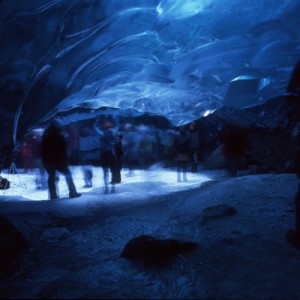 Glaciers are slow. In idiomatic English, to move at a “glacial pace” is to move so slowly that a casual observer will not notice the movement at all. Yet over the years I’ve been making images featuring glacial ice, the rate of observable change is phenomenally fast. Even as I compose and capture an image, the ice is melting and the image is disappearing. The majestic, glowing cavern of today is the rotted, open-top canyon of the next week. It is dry open rock the week after that.
Glaciers are slow. In idiomatic English, to move at a “glacial pace” is to move so slowly that a casual observer will not notice the movement at all. Yet over the years I’ve been making images featuring glacial ice, the rate of observable change is phenomenally fast. Even as I compose and capture an image, the ice is melting and the image is disappearing. The majestic, glowing cavern of today is the rotted, open-top canyon of the next week. It is dry open rock the week after that.
The folks at Extreme Ice Survey make time-lapse images of melting ice around the world. Two of their cameras are trained on “my” glacier, the Mendenhall, and their one-minute video covers seven years of activity. Time-lapse video is an excellent medium to convey the enormous change which takes place at a “glacial pace”. I don’t have an MF3D time-lapse video. I create still images. I offer you only a single still, and ask, “How do we identify the ghosts?”
Today, fourteen months after that image was made, those ghostly people still walk the planet. The blue palace at which they marveled melted off into the ocean long ago.
[Edited July 8, 2015 to add]
I visited the ice this week and am saddened by what I found. Because of the continued ice-recession, the walk is much longer and harder than it was a few years ago, and the destination is a pathetic shadow of its former self. This may be the final image of my ice series.
Global Geometry
Thanks to Steve Lederman for scanning these images for me!
Steve also developed the film for me in his home-basement-lab.
Metal sculpture by Canadian sculptor Roy Hickling.
GEOMETRY
This series of photographs all feature circular sculptural pieces set against various items, creating some interesting geometry. I especially liked the circular globe set with the squares, rectangles and triangles of the mid to late 1800’s barn.
GLOBAL FOCUS
Again, this image places several shapes throughout the stereo image. I was also interested in the challenge the shadows brought to this shot.
IMPLOSION TO THE NORTH
This image features a complex globe with an interesting movement of its structural pieces towards what I imaged as “north” in this piece. This image was actually quite difficult to mount for me. I am still trying to get the hang of mounting certain images.
APPARITIONS
This was a triple exposure – on purpose – where I was trying to not completely blow out the exposure. It isn’t a great shot, but it was a great experiment I wanted to share. To be honest, the more experimental approach is where my heart is – and where most of my shots land.
From our guest, Matt Neima
- Ricketts Glen
- Rondeau Provincial Park
- Killarney Provincial Park
- Whistler Alpine plants
Killarney Park
Before I forget, thanks to Steven Lederman for scanning these pictures for me! I think this was Delta 100 and processed by DR5.
This picture was taken on the chikanishing trail. Spoiler for me is the right image has a reflection or something that once you see it (sorry!) it becomes very distracting.
I wonder if it’s possible to touch up the emulsion to fix this….
Rondeau Park
Talk about harsh lighting! I think this went around in the IMF3D folio. Some people liked it, some people really didn’t like it. This was taken with my Spud a long long time ago.
Ricketts Glen
Taken with the TL-120 in Pennsylvania on a camping trip with James Mutch. There are a lot of waterfalls in a small area here. At one waterfall J and I watched a pro photographer taking a classic fall colour waterfall shot. His assistant held a maple branch with red leaves in front of the camera while he took pictures.
Whistler
Taken with a TL-120 on the same trip to Vancouver a few years back. At that time I posted a picture of my nephew on his roller skates. I’m hoping this is a new image to this folio.
RACK AND PINHOLE
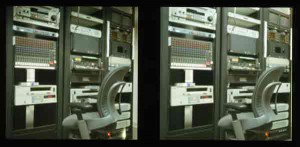 For loop 28, I’ve decided to submit four different images captured with four different medium format stereo cameras. This first image was captured with my “Rollei Pin” camera that I created for this year’s Worldwide Pinhole Day. Gary Cullen supplied a junked Rolleidoscop body, and I created a lensboard out of a Wellington Stout aluminum can. Matt Neima and James Mutch originally sparked my interest in pinhole photography, and this year when I participated in Worldwide Pinhole Day I recruited Ray Dillard into the fold. You can see the image I submitted to the WWPD gallery here: http://pinholeday.org/gallery/2015/index.php?id=2712
For loop 28, I’ve decided to submit four different images captured with four different medium format stereo cameras. This first image was captured with my “Rollei Pin” camera that I created for this year’s Worldwide Pinhole Day. Gary Cullen supplied a junked Rolleidoscop body, and I created a lensboard out of a Wellington Stout aluminum can. Matt Neima and James Mutch originally sparked my interest in pinhole photography, and this year when I participated in Worldwide Pinhole Day I recruited Ray Dillard into the fold. You can see the image I submitted to the WWPD gallery here: http://pinholeday.org/gallery/2015/index.php?id=2712
Both of these exposures were 25 minutes and 15 seconds long, 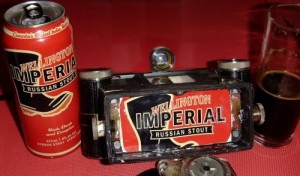 captured with The Rollei Pin on Kodak E100S film, and home-processed in my basement. Now before some of you whine and moan that this image isn’t tack sharp (after all, it was taken with a pin, not a tack) just think about it for a moment – this was captured using a beer can for a lens! Here is a picture of the Rollei Pin, along with its lens source (shot with a W3):
captured with The Rollei Pin on Kodak E100S film, and home-processed in my basement. Now before some of you whine and moan that this image isn’t tack sharp (after all, it was taken with a pin, not a tack) just think about it for a moment – this was captured using a beer can for a lens! Here is a picture of the Rollei Pin, along with its lens source (shot with a W3):
SILL LIFE
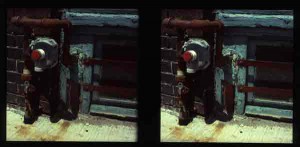 The textures of the various elements on this empty store front caught my eye while I was exploring Toronto’s Junction district earlier this month. A guy came out of the apartment adjacent to the store and said; “what are you shooting? Cityscapes? This is my store…I guess I should paint it, huh?” I looked up from my crouched position and said; “no! Not on my account!” Maybe I’ll go back and shoot a couple of rolls of black ‘n’ white film before the owner decides to turn this derelict store into apartments.
The textures of the various elements on this empty store front caught my eye while I was exploring Toronto’s Junction district earlier this month. A guy came out of the apartment adjacent to the store and said; “what are you shooting? Cityscapes? This is my store…I guess I should paint it, huh?” I looked up from my crouched position and said; “no! Not on my account!” Maybe I’ll go back and shoot a couple of rolls of black ‘n’ white film before the owner decides to turn this derelict store into apartments.
This image was captured with a stock TL-120-1, on Velvia 100 shot at 200 and then home-push-processed in my basement. The Velvia 100 was actually 22o format – I’ve worked out a winding sequence for the TL-120 that allows me to use 220 film in it as long as the little aluminum sliding door stays closed over the red window. When I started using 220 film in my TL-120-1 I forgot about the aluminum sliding door and had an entire roll come out with transparent red balls embedded in the images. I gave the useable ones titles with the word “Mars” in it, i.e. “Mars Needs Gas”. Each image on the roll looked like it was being invaded by the planet Mars.
LIBERTY FOR ALL
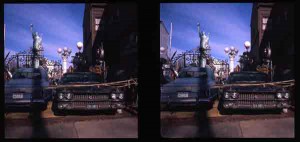 I paid my respects at “Colonel” Harland Sander’s grave in Louisville KY, then drove over to Jerry Lotz’s place to take a gander at his massive collection of stuff. As luck would have it, Jerry saw me taking pictures and came out to talk about his collection. I was invited inside to see even more of the hoard, and shot that part of the impromptu tour with a digital stereo infrared rig.
I paid my respects at “Colonel” Harland Sander’s grave in Louisville KY, then drove over to Jerry Lotz’s place to take a gander at his massive collection of stuff. As luck would have it, Jerry saw me taking pictures and came out to talk about his collection. I was invited inside to see even more of the hoard, and shot that part of the impromptu tour with a digital stereo infrared rig.
This image was captured with a 1930 Rolleidoscop on AGFA RSX II film, and home-processed in my basement.
CLOSED, HORSE
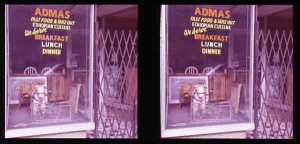 There are pockets of Bloor Street in Toronto that are gentrified and developed, and some that are…questionable. When I captured this image last year I assumed that the restaurant had long been abandoned, but just last week I saw them open and catering to customers.
There are pockets of Bloor Street in Toronto that are gentrified and developed, and some that are…questionable. When I captured this image last year I assumed that the restaurant had long been abandoned, but just last week I saw them open and catering to customers.
This was shot with the twinned AGFA Isolette folder that Sam Smith created, on very expired Kodak E100 (no, that’s not an Instagram filter), and home-processed in my basement.
New Mexico Moods
Kitch Gitten Place
This Sante Fe shop keeper agreed to have this environmental portrait done in the doorway. The Open shade made Velvia the choice – interior light balanced well by luck.
Crown Jewels
I like shooting store windows – reflections vs. transluscence. Thi one is more about the stuff, the sunflowers, and signage.
Abandoned Adobe
Velvia worked wll for this lighting scenario – side sun. I love how it saturates the colors.
One Man’s Junk
I was absolutely awestruck when I came upon this scene. The picket fence, the metal barn, the broken glass, even the wires in the sky… and wow, what a sky.

